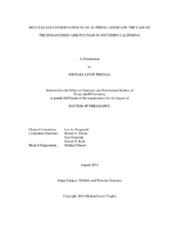| dc.description.abstract | Habitat loss and degradation are recognized as significant drivers of biodiversity loss in terrestrial and freshwater ecosystems. These issues are often associated with anthropogenic land cover changes, which can have direct and indirect impacts on species, and conservation strategies must take both into account for long-term success. I focused this dissertation on the endangered arroyo toad (Anaxyrus califonicus), endemic to southern California, USA and northern Baja California, Mexico. The species relies on open, sandy streams for breeding and larval development, and the adjacent terrestrial environments for post-metamorphosis life stages; primary threats include destruction and degradation of these habitats.
I conducted three studies to better understand threats to, and identify conservation opportunities for arroyo toads in southern California. First, I developed distribution models that enabled me to identify areas that could be used to create habitat for the species, which could then be colonized by nearby populations or populated via translocation efforts. Second, I used structural equation modeling to investigate relationships among land cover characteristics at multiple spatial scales and suitability of riparian areas for arroyo toads. This study yielded insight into how land cover of entire watersheds and along stream networks influence arroyo toad habitat. Lastly, I used a structural equation model in conjunction with a projection of development for my study area to forecast how future urbanization may influence suitability of habitats for arroyo toads in individual watersheds. I compared results for scenarios with high and low levels of urbanization, and found conservation of natural land covers at the watershed scale can ultimately help maintain habitat in the long-term.
The results of these studies may guide both immediate and future conservation efforts for arroyo toads in my study area. My approaches can be applied to other systems for understanding conservation issues affecting other species. Furthermore, future work may build on this research to inform conservation in other parts of the arroyo toad’s range, and models can be iteratively improved as land cover changes occur and the species responds through time. | en |


